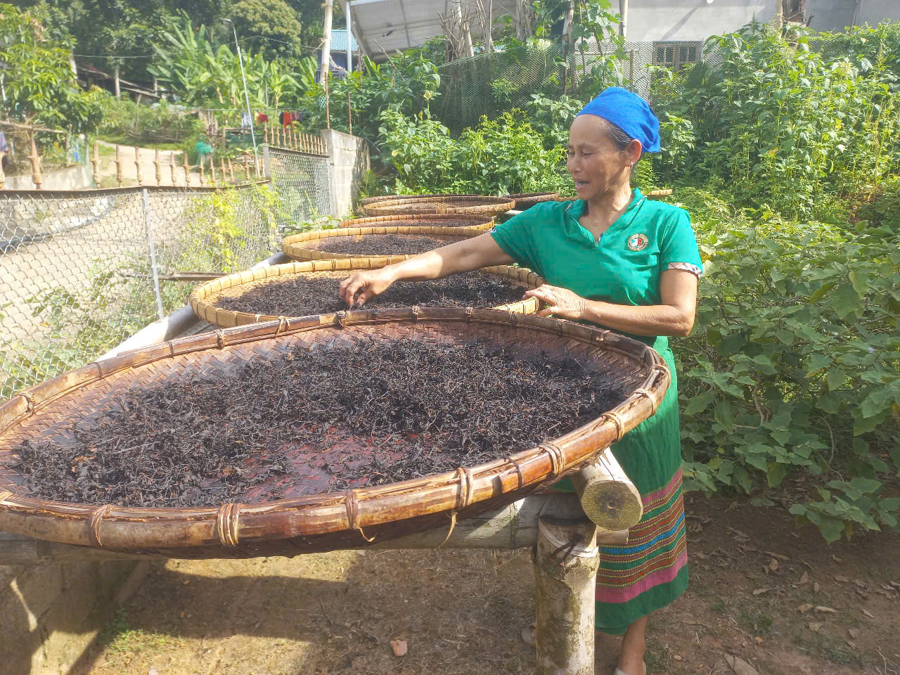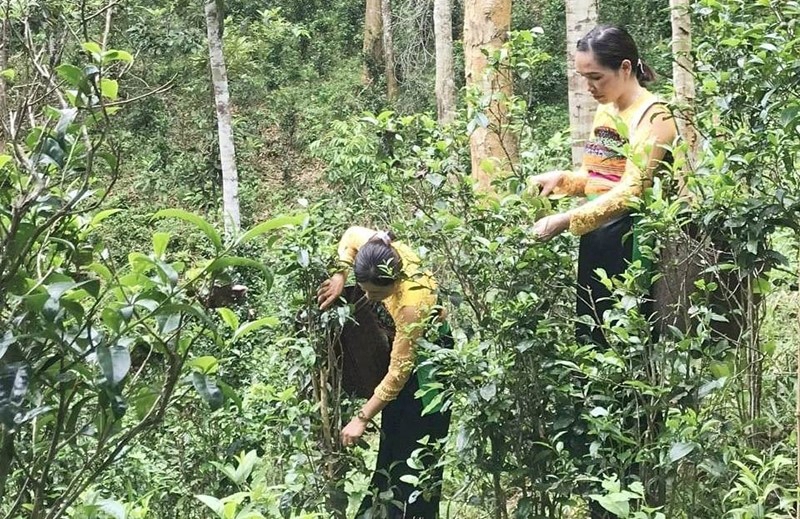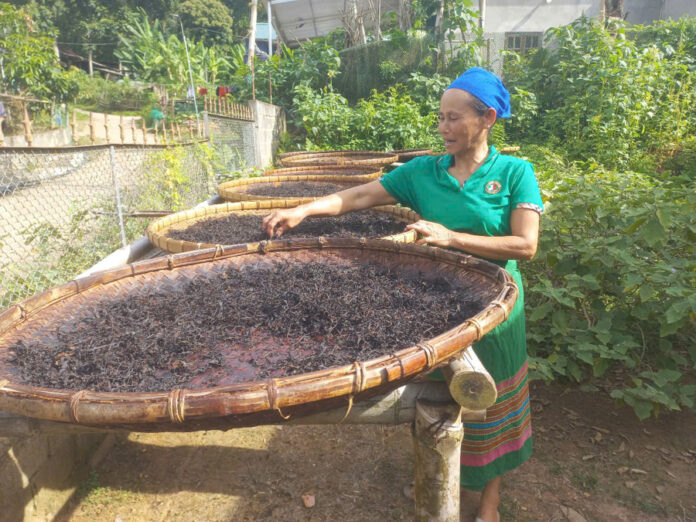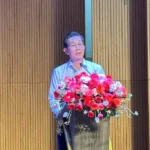In the serene summer days of Ban Phun, Trung Xuan, Quan Son District, a gentle mountain mist hangs in the early morning breeze. In a small stilt house, Ha Thi Thao stokes a coal stove and boils water to brew a pot of fragrant tea for her guests. “This is Tan Ma tea, a delicacy of the Thai people from these mountains,” she says softly, offering a cup to her guests.
PRESERVING THE AROMA OF THE FOREST IN A CUP OF TAN MA TEA
In the Thai language, “Tan Ma” translates to “honored guest.” It is both a name for this unique tea and a heartfelt greeting from the mountainous region. Traditionally, the Thai people led a nomadic life, and while they might forget their rice bags or cooking pots, they never left home without their Tan Ma tea. “Tea is a symbol of hospitality and respect. How can we welcome guests without offering tea?” Thao explains.
Tan Ma tea grows wild in the forests. In the past, locals would pluck the leaves, dry them, and brew a refreshing drink to combat fatigue. Over time, offering a cup of Tan Ma tea became a customary way to greet visitors. The reddish-orange beverage has a scent reminiscent of the forest after rain, a sweet aftertaste, and a warming effect on those who sip it.

Unlike conventional green tea, Tan Ma tea buds are small, with naturally curled leaves. When dried, the leaves turn a dark brown, but when brewed, they take on an amber or reddish-orange hue, shimmering in the clay teacup. The tea has a gentle, subtly sweet flavor, devoid of the strong bitterness often associated with green tea. This reflects the gentle nature of its makers…
The Thai people have a unique method of preparing Tan Ma tea. They pluck the leaves early in the morning on sunny days, shade-dry them, and then gently rub the withered leaves with their hands. The tea is then misted with morning dew, sun-dried, and stored in large earthenware jars or vases.
Ha Thi Thao shares, “Since becoming a daughter-in-law in Ban Phun, I’ve learned the art of plucking, rubbing, and drying Tan Ma tea from my mother-in-law to ensure the best flavor. The tea plants in our garden have been here since before I arrived. Previously, my mother-in-law and I would pluck and process the tea for our daily use and to gift to friends and family who visited.”
A NEW DIRECTION FOR SUSTAINABLE DEVELOPMENT IN THE MOUNTAINOUS REGIONS
Tan Ma tea is more than just a drinking tradition; it is now seen as a sustainable path to economic development in these mountainous areas. Once a little-known local product, Tan Ma tea has emerged from the villages and entered the “One Commune, One Product” (OCOP) program, gradually becoming a key product in the mountainous communes of Quan Son and Quan Hoa districts.
In the commune of Hien Kiet, Quan Hoa District, located at an altitude of over 700 meters with a cool climate and fertile soil, locals have boldly shifted from wild tea plucking to concentrated cultivation. By intercropping tea with forest trees, the tea plants require less chemical fertilizers and pesticides, meeting clean production standards. Currently, the commune boasts nearly 50 hectares of Tan Ma tea, cultivated by Thai households.
With its distinct flavor and traditional handmade process, Tan Ma tea not only provides stable incomes for locals but also underscores the potential of mountain products in the sustainable economic development strategy.
Since 2021, the product “Hien Kiet Tan Ma Tea” has officially been recognized as a 3-star OCOP product by the provincial government. Hundreds of kilograms of dried tea are processed and sold monthly, with an average price of 150,000–200,000 VND/kg. Many households have significantly improved their incomes thanks to Tan Ma tea.
In Trung Xuan, Quan Son District, a women-led Tan Ma tea production group is also demonstrating positive results. With over 30 members cultivating 5 hectares of tea, the group focuses not only on processing but also actively participates in OCOP fairs and events to promote their product. As a result, Tan Ma tea from Trung Xuan is gaining recognition among consumers and has become a beloved specialty gift for tourists.
Some households have even ventured into producing tea bags, instant tea, and handcrafted boxed tea with attractive packaging and eco-friendly materials. These innovations have increased the value of Tan Ma tea and expanded its market reach. Several community tourism tours in Pu Luong, Sam Son, and Mai Chau now include Tan Ma tea as a gift for their guests.

According to the authorities in Quan Son District, the development of Tan Ma tea not only brings economic benefits but also contributes to the preservation of local knowledge, empowers women, and protects the ecological environment. Tea plants are intercropped under the natural forest canopy, helping to conserve soil and water, reduce erosion, and provide long-term livelihoods for highland residents.
Mr. Ha Hoang Thanh Tam, Deputy Head of the Agriculture and Environment Office of Quan Son District, suggests that to obtain OCOP recognition for Tan Ma tea from Ban Phun, Trung Xuan Commune, it is necessary to expand the growing area and apply scientific and technical advances in the care, harvesting, and processing stages to improve productivity and quality.
Additionally, Mr. Tam recommends improving packaging designs, building brands, and reorganizing production from household groups to cooperatives to strengthen production and consumption linkages and expand the growing area.
In the long term, the locality aims to establish stable raw material sources, develop Tan Ma tea into a sustainable OCOP product linked to local tourism and culture, enhance product commercialization capabilities, create stable jobs, and encourage local residents to protect the forests and their communities.
In the midst of modernization, it is heartening to see a traditional product like Tan Ma tea retain its rustic, handmade qualities and community connections. This preservation goes beyond economic benefits, embodying the culture, memories, and legendary hospitality of the Thai people in the highlands of Thanh for generations.
Flexible Finance: The Future of Safe and Sustainable Consumer Lending
In a challenging economic climate, there is a growing need for accessible consumer credit, particularly for individuals and households. Providing flexible financial solutions not only expands access to capital but also stimulates consumer spending and boosts economic growth.





















